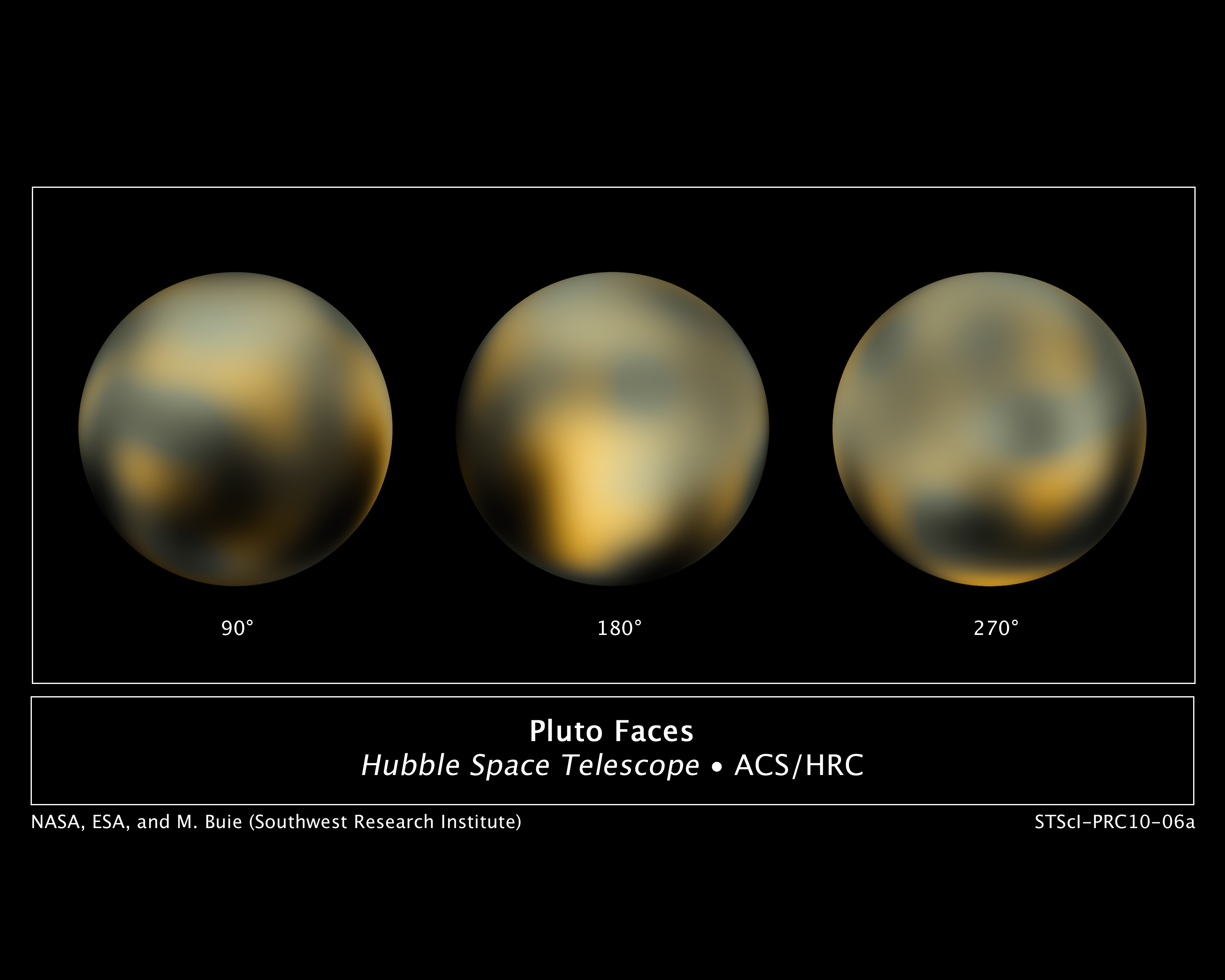







| BOOKS | F. A. Q. | ARTICLES | TALKS | ABOUT KEN | DONATE | BEYOND OUR KEN |
|---|

By Ken Croswell
Published in The Wall Street Journal (February 18, 2010, page A19)
"I'm not a Republican and I'm not a Democrat...for years I've
been a Plutocrat."
--Clyde Tombaugh, discoverer of Pluto
The 2006 vote by a few hundred astronomers to strip Pluto of its planetary status was supposed to end a longstanding dispute. Instead, hundreds of other astronomers signed a petition saying they didnít recognize the vote and would continue regarding Pluto as a planet in our solar system. Nonastronomers started peppering me with questions like, ďWhy did you guys do something so stupid?Ē An entire blog (laurele.livejournal.com) arose to restore Plutoís planethood. And a 2009 CNN.com poll found an overwhelming majority favoring the pro-Pluto side.
The passion for Pluto is understandable. Discovered 80 years ago today by a young astronomer from Kansas named Clyde Tombaugh, Pluto is so distant that sunlight, which takes just eight minutes to reach Earth, requires several hours to strike Pluto. This incredibly distant world--Plutoís average distance from the Sun is 3.67 billion miles--orbits the Sun only once every 248 years.
Itís little wonder then that Pluto has long inspired explorers. Whereas spacecraft have flown past every planet from Mercury to Neptune, no probe has ventured to Pluto. Thus, no one knows exactly what it looks like. All we know is that Pluto is a frigid world of rock and ice, accompanied by three moons and enveloped in an atmosphere of nitrogen, the same gas that makes up most of our air.
How did astronomers get into a pickle over Pluto? For many years they thought it was larger than it actually is. A 1950 observation put Pluto halfway in size between Mercury and Mars. Thus, Plutoís diameter seemed to plant it firmly in the planetary firmament. But observations in the 1970s and 1980s revealed that Pluto is smaller. In fact, Pluto is only half the diameter of Mercury. But thatís more than twice the diameter of Ceres, the largest asteroid. So what is Pluto? Planet? Or asteroid?
Then, in 1992, astronomers started to find other objects revolving around the Sun beyond Neptuneís orbit. Most of these objects are much smaller than Pluto. But the discoveries mean Pluto belongs to a belt resembling one that Irish astronomer Kenneth Edgeworth postulated in 1943 and American astronomer Gerard Kuiper in 1951. The Edgeworth-Kuiper belt harbors more than a thousand known objects. All but one are smaller than Pluto.
The controversial 2006 vote demoted Pluto by demanding a proper planet satisfy a newfangled criterion: it must clear its orbital zone around the Sun, which means nothing substantial should cross its path. This criterion Pluto spectacularly fails. For one thing, Pluto belongs to the Edgeworth-Kuiper belt, with its myriad objects. For another, the distant world crosses Neptuneís orbit. From 1979 to 1999, Pluto was the eighth planet from the Sun, not the ninth.
But this definition of a planet runs into major problems. Even if the Earth, whose diameter is more than five times Plutoís, belonged to the Edgeworth-Kuiper belt, it would not be considered a planet, for it would not have cleared out its orbital zone. Furthermore, astronomers have discovered planets beyond our solar system that--wait for it--cross each otherís orbits, just as Neptune and Pluto do.
Fortunately, a better definition exists: a planet of our solar system is an object that orbits the Sun and has a diameter that equals or exceeds Plutoís. This definition is clear and simple. It preserves the planethood Pluto has enjoyed since its discovery. And because Pluto is rather large, this definition wonít confer planethood on every last iceball beyond Neptune. So the word planet will continue to connote an important object orbiting the Sun.
Yes, you read that right. Pluto is rather large. Itís the tenth largest object that goes around the Sun. Pluto looks dim primarily because of its great distance. Thus, the sunlight striking it is weak, and this light gets further attenuated during the long trek back to Earth. But put Pluto in place of Mars and, when closest to Earth, Pluto would outshine every star at night.
This definition means the Sun has ten known planets: Mercury, Venus, Earth, Mars, Jupiter, Saturn, Uranus, Neptune, Pluto, and Eris. Discovered in 2005, Eris is the farthest object ever seen in our solar system. Itís currently 9 billion miles from the Sun, three times farther than Pluto. And itís slightly bigger than Pluto. Like Earth, Eris even has a moon.
In 2015, a spacecraft will fly past Pluto and resolve many of the puzzles surrounding a world that has been mysterious since its discovery. But Eris ensures that the mysteries of another distant planet will beckon, inspiring future generations just as Pluto has inspired ours.
Ken Croswell is an astronomer and the author of Magnificent Universe and Ten Worlds.
"Magnificent Universe by Ken Croswell is elegant and eloquent."--Washington Post. See all reviews of Magnificent Universe here.
"On the basis of its striking design and photographs, this handsome, large-format volume is well worthy of praise. And astronomer Croswell's concise yet conversational, information-packed text wins it sky-high accolades in the narrative sphere as well."--Publishers Weekly, starred review. See all reviews of Ten Worlds here.
| BOOKS | F. A. Q. | ARTICLES | TALKS | ABOUT KEN | DONATE | BEYOND OUR KEN |
|---|